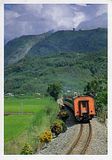
 Turnul Colţei (also Turnul Colţea or Colţii) was a tower located in Bucharest, Wallachia, now in Romania. Having a height of 50 metres, it was the highest building in the city for more than a century. Its initial purpose was to be used as a bell tower — its 1.700 kg bell, was moved to the Sinaia Monastery after the tower was demolished. Its was also meant to serve as a watch tower.
Turnul Colţei (also Turnul Colţea or Colţii) was a tower located in Bucharest, Wallachia, now in Romania. Having a height of 50 metres, it was the highest building in the city for more than a century. Its initial purpose was to be used as a bell tower — its 1.700 kg bell, was moved to the Sinaia Monastery after the tower was demolished. Its was also meant to serve as a watch tower.The tower was named after Vornic Colţea Doicescu. His brother, Udrea Doicesu, built a small wooden church on the plot near the tower; after he was assassinated, the church and the land next to it were inherited by Colţea, who donated them to the Orthodox Church. The Church sold the patch of land near the church to Spătar Mihai Cantacuzino, who, in 1701, used it as the location for the first hospital in Wallachia, the Colţei Hospital, and also decided to build a tower.
The tower was built between 1709 and 1714, its construction being assisted by the Swedish soldiers of the army of King Charles XII, who had fled to Wallachia after the disastrous defeat at the Battle of Poltava. Mihai Cantacuzino kept his secret archive inside the tower.
An earthquake on October 14, 1802 destroyed its top part, including its clock; in 1888, it was demolished completely. Two years later, in 1890, another structure was built as a watch tower, Foişorul de Foc.































No comments:
Post a Comment